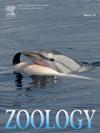Bite force variation in the European pond turtle: Role of morphology, strength, body condition and population of origin
IF 1.6
3区 生物学
Q2 ZOOLOGY
引用次数: 0
Abstract
Bite force is a biomechanical trait that serves as a valuable proxy for assessing ecological interactions, feeding specialisations, and evolutionary pressures. Chelonians are a unique model system in studies of masticatory performances due to their akinetic skull and lack of teeth. It is known that body size, head morphology and sex-related differences influence bite performance of some chelonian species. In this study, we investigated the variation in bite force within and among five populations of the European pond turtle (Emys orbicularis) in Serbia. We examined relationship of bite force with phenotypic traits such as body size, head dimensions, body condition and muscle strength, as well as body temperature and seasonality. Bite force was measured in the field (N = 209) with an adapted digital force sensor. Our results showed significant differences in bite force across populations, suggesting that local ecological conditions may play a crucial role in shaping bite performance. In particular, turtles from more diverse and structurally complex environments, and turtles sharing their habitat with non-native pond sliders (Trachemys scripta ssp.) exhibited higher bite forces. We also detected a positive association between bite force and maximal pulling force, volumetric body condition index, body size and head height. Surprisingly, sex, cloacal temperature and seasonality were not significant predictors of bite force. Despite the challenges of measuring maximal performance under field conditions, our findings illustrate how variation in functional traits can reflect both intrinsic factors and ecological context, with implications for the study of biomechanical adaptations across animal taxa.
欧洲塘龟咬合力的变化:形态、力量、身体状况和种群起源的作用。
咬合力是一种生物力学特征,可以作为评估生态相互作用、捕食专业化和进化压力的有价值的代理。由于龟类动物的颅骨不动且没有牙齿,因此在研究咀嚼行为方面是一个独特的模型系统。已知身体大小,头部形态和性别相关的差异影响某些龟种的咬伤性能。在这项研究中,我们调查了在塞尔维亚的欧洲池龟(Emys orbicularis)的五个种群内和之间的咬合力的变化。我们研究了咬合力与身体大小、头部尺寸、身体状况和肌肉力量、体温和季节等表型性状的关系。在现场用适应的数字力传感器测量咬合力(N = 209)。我们的研究结果显示,不同种群的咬合力存在显著差异,表明当地的生态条件可能在塑造咬合力方面起着至关重要的作用。特别是,来自更多样化和结构复杂环境的海龟,以及与非本地池塘滑梯(Trachemys scripta ssp.)共享栖息地的海龟表现出更高的咬合力。我们还发现咬合力与最大拉力、体积身体状况指数、身体尺寸和头高呈正相关。令人惊讶的是,性别、肛管温度和季节并不是咬合力的显著预测因子。尽管在野外条件下测量最大性能存在挑战,但我们的研究结果说明了功能性状的变化如何反映内在因素和生态环境,这对动物分类群的生物力学适应研究具有重要意义。
本文章由计算机程序翻译,如有差异,请以英文原文为准。
求助全文
约1分钟内获得全文
求助全文
来源期刊

Zoology
生物-动物学
CiteScore
3.90
自引率
0.00%
发文量
37
审稿时长
70 days
期刊介绍:
Zoology is a journal devoted to experimental and comparative animal science. It presents a common forum for all scientists who take an explicitly organism oriented and integrative approach to the study of animal form, function, development and evolution.
The journal invites papers that take a comparative or experimental approach to behavior and neurobiology, functional morphology, evolution and development, ecological physiology, and cell biology. Due to the increasing realization that animals exist only within a partnership with symbionts, Zoology encourages submissions of papers focused on the analysis of holobionts or metaorganisms as associations of the macroscopic host in synergistic interdependence with numerous microbial and eukaryotic species.
The editors and the editorial board are committed to presenting science at its best. The editorial team is regularly adjusting editorial practice to the ever changing field of animal biology.
 求助内容:
求助内容: 应助结果提醒方式:
应助结果提醒方式:


